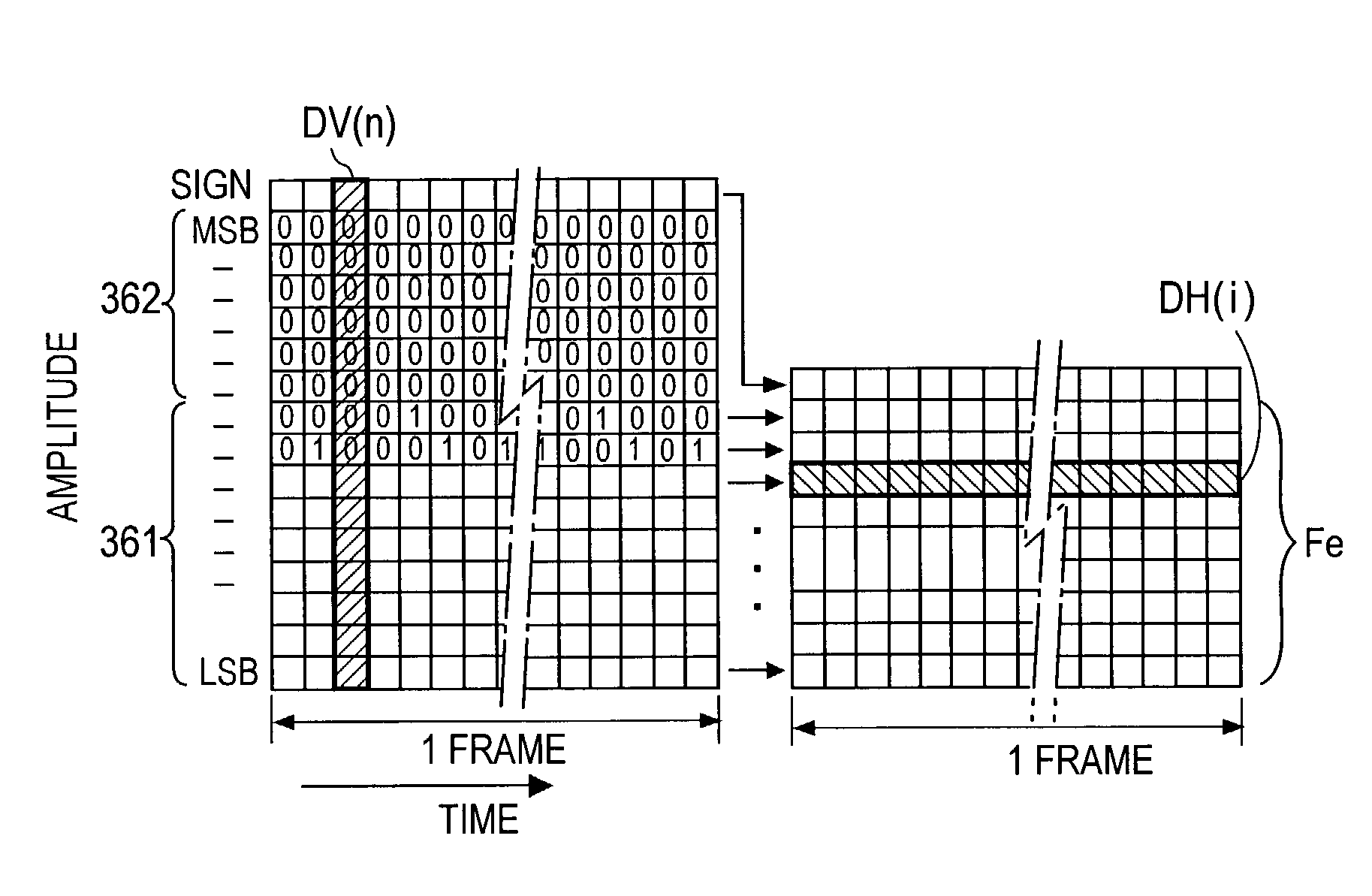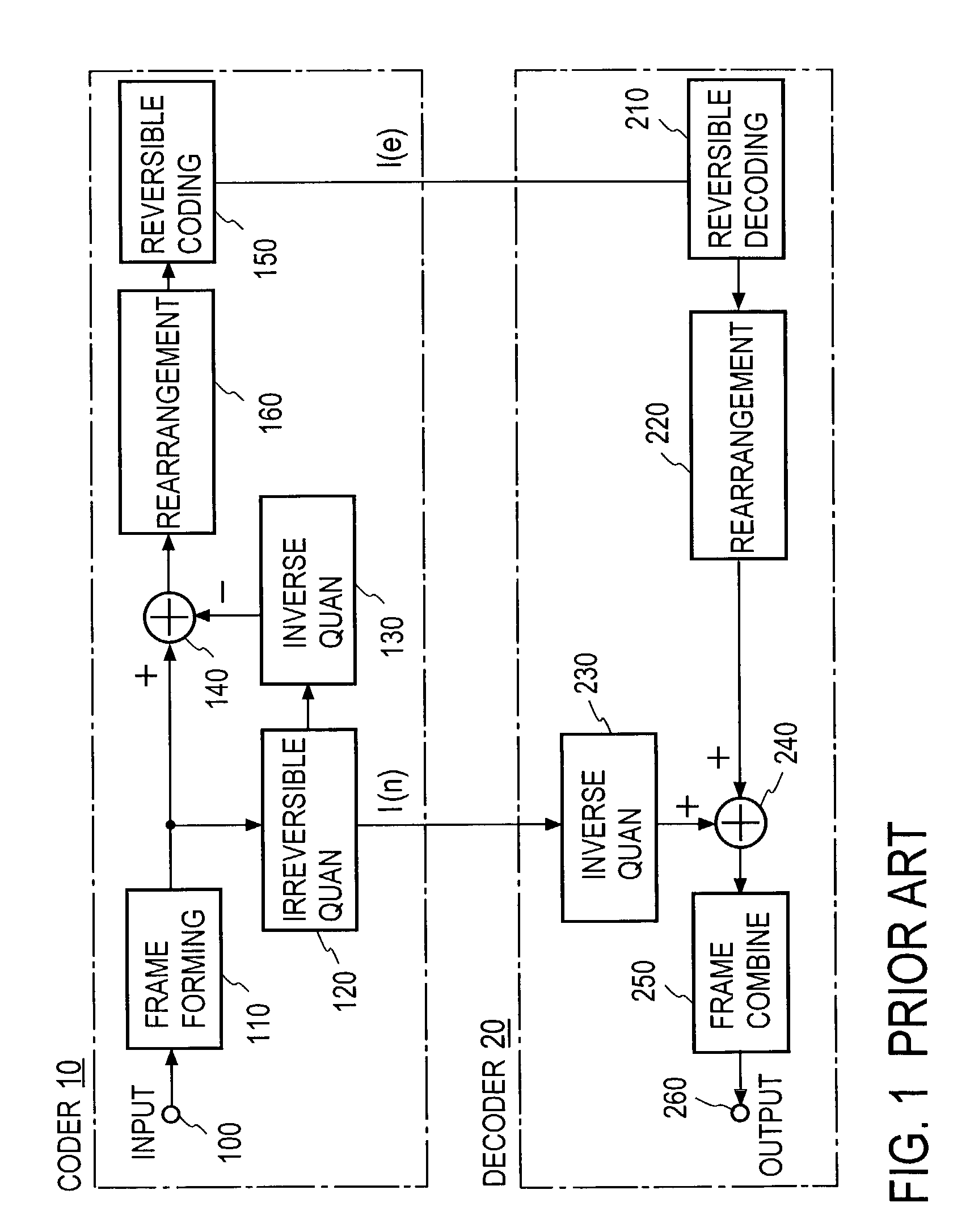Digital signal coding and decoding methods and apparatuses and programs therefor
a digital signal and signal technology, applied in the field of digital signal coding and decoding methods and apparatuses and programs therefor, can solve the problems of degrading the quality of the reconstructed signal, degrading the reconstructed signal, and not being able to achieve 1/3 or 1/4 compression ratio
- Summary
- Abstract
- Description
- Claims
- Application Information
AI Technical Summary
Benefits of technology
Problems solved by technology
Method used
Image
Examples
embodiment 1
[0082]In FIG. 3 there are depicted in block form the coder 10 and the decoder 20 according to this embodiment of the present invention. This embodiment differs from the FIG. 1 prior art example in the provision of a header adding part 320, which sends out signals in a packet to reduce the influence of a bit error during transmission on the quality of reconstructed signal.
[0083]In the coder 10 an input signal sample sequence from an input terminal 100 is separated by a frame forming part 110 into frames each consisting of, for example, 1024 input signal samples (that is, n=samples at 1024 sample points), and in the rearrangement part 160 bits at each bit position in amplitude bit sequences of the respective samples are formed in the frame. In this case, the amplitude of the input signal sample sequence is represented by a positive or negative integer in the 2's complement format; it is preferable that, as is the case with the prior art, each sample represented in the 2's complement f...
embodiment 2
[0097]FIG. 6 illustrates in block form a second embodiment of the present invention. In the coder 10 the input signal sample sequence separated for each frame in the frame forming part 110 is provided to an auxiliary information generating part 350. The auxiliary information generating part 350 comprises a spectral envelope calculating part 351, a power calculating part 354 and an auxiliary information coding part 352. The input signal sample sequences separated in the frame forming part 110 for each frame are provided to the spectral envelope calculating part 351, wherein coefficients representing the spectral envelope are calculated, for example, as linear prediction coefficients LPC by linear predictive analysis, and in the power calculating part 354 the average power Pa of the input signal sample sequences for each frame is calculated.
[0098]Alternatively, the input signal sample sequences are input to an inverse filter 355 formed based on the linear prediction coefficients LPC, ...
embodiment 3
[0118]FIG. 11 illustrates in block form a third embodiment of the present invention applied to the coding scheme that is a combination of the high-compression-ratio irreversible coding described previously with reference to the FIG. 1 prior art example and the reversible compression of the error signal between the reconstructed signal and the original signal. As is the case with the FIG. 1 prior art example, in the coder 10 the digital input signal sequence from the input terminal 100 is irreversibly quantized in the high-compression-ratio irreversible quantization part 120, then the quantized information is inversely quantized (that is, decoded) in the inverse quantization part 130, then the difference between the inversely quantized signal (reconstructed signal) and the original digital input signal sequence from the input terminal 100 is calculated in the subtraction part 140, and the error signal that is the difference signal is applied to the frame forming part 110. That is, as...
PUM
 Login to View More
Login to View More Abstract
Description
Claims
Application Information
 Login to View More
Login to View More - R&D
- Intellectual Property
- Life Sciences
- Materials
- Tech Scout
- Unparalleled Data Quality
- Higher Quality Content
- 60% Fewer Hallucinations
Browse by: Latest US Patents, China's latest patents, Technical Efficacy Thesaurus, Application Domain, Technology Topic, Popular Technical Reports.
© 2025 PatSnap. All rights reserved.Legal|Privacy policy|Modern Slavery Act Transparency Statement|Sitemap|About US| Contact US: help@patsnap.com



